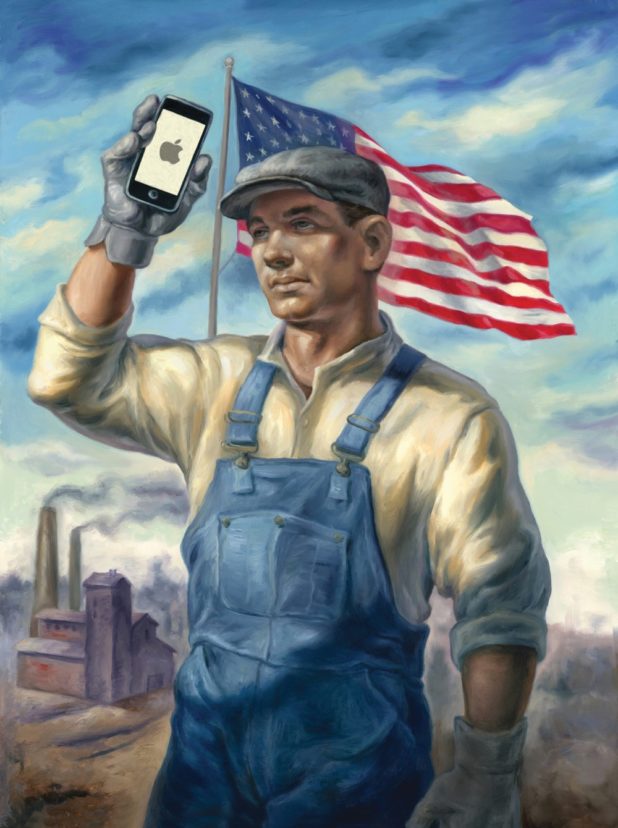Andrew Anglin
Daily Stormer
November 19, 2016
Apple is preparing to surrender to The Leader.
Apple has asked its primary manufacturing partners, Foxconn and Pegatron, to explore making iPhones in the US, Nikkei reported on Thursday.
Foxconn has worked on a plan, according to the report, but Pegatron has not, saying that it would be too expensive. Foxconn Chairman Terry Gou is reportedly lukewarm on the plan, too, because of the rise in production costs.
Foxconn’s second most powerful executive, Sharp President Tai Jeng-Wu, talked about making parts in the United States during a recent public speech.
“We are now building a new [OLED] facility in Japan. We can make [OLED panels, a kind of screen] in the US too,” he said. “If our key customer demands us to manufacture in the US, is it possible for us not to do so?”
One key reason Apple might be considering a made-in-America iPhone is because President-elect Donald Trump has publicly called for the company to build its product in the US, and threatened tariffs on imports from China.
Note: By “one key reason” they of course mean “the only reason.”
“I’m going to get Apple to start making their computers and their iPhones on our land, not in China,” Trump said during a rally in March. “How does it help us when they make it in China?”
…
There are many reasons a made-in-America iPhone is improbable, starting with cost. “Making iPhones in the US means the cost will more than double,” a source told Nikkei.
But there are other problems. Most of the parts that go into an iPhone come from companies in Asia, and the just-in-time manufacturing processes that Apple uses mean that shipping components across the Pacific Ocean could become costly.
“A large part of the reason electronics moved overseas is because of the entire supply chain over there,” Columbia economics professor Amit Khandelwal previously told Business Insider. “It may be a lower cost to produce the final product as compared to the US, but there’s also an advantage is that you’re close to your other input suppliers who are other parts of the East Asia supply chain.”
This is just nonsense/lies.
MIT Technology Review did a study on this earlier this year, and assembling them in the US would add only an estimated 5% to the cost:
Today Apple contractors assemble iPhones in seven factories—six in China and one in Brazil. If the phones were assembled in the U.S. but Apple still sourced components globally, how much would that change the price of the device?
According to IHS, a market analyst, the components of an iPhone 6s Plus, which sells for $749, cost about $230. An iPhone SE, Apple’s newest model, sells for $399, and IHS estimates it contains $156 worth of components.
Assembling those components into an iPhone costs about $4 in IHS’s estimate and about $10 in the estimation of Jason Dedrick, a professor at the School of Information Studies at Syracuse University. Dedrick thinks that doing such work in the U.S. would add $30 to $40 to the cost. That’s partly because labor costs are higher in the U.S., but mostly it’s because additional transportation and logistics expenses would arise from shipping parts, and not just the finished product, to the U.S. This means that assuming all other costs stayed the same, the final price of an iPhone 6s Plus might rise by about 5 percent.
Is there anyone who wouldn’t pay an extra 5% for a phone made in America?
And if they won’t pay it, then guess what? Apple is going to have to pay it. Either that, or they can keep making them in China and pay even more when Trump tax-attacks them.
Of course, I get that the 5% is just on assembly, and we want all of the parts made in the US. But they are saying that the increase in cost is mostly associated with shipping the parts from Asia. So if they aren’t shipped from Asia, and are instead manufactured in the same place as the phones are assembled, then what?
I’m not a mathematician, but what I do know is that it doesn’t matter. Either Apple comes home, or we tax them so much they will cost $10,000 each.

